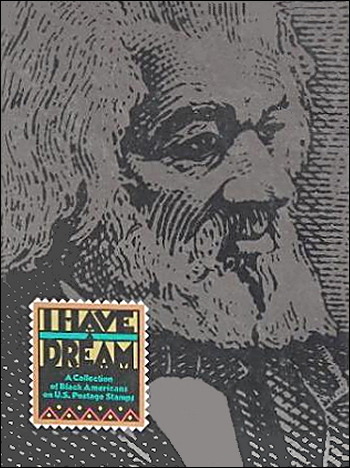I Have a Dream: U.S. Postage Stamps (1991)

Throughout the years, the United States Postal Service has tried to preserve America’s rich history and culture through its commemorative stamp program.
The Postal Service has issued Black History-related stamps to commemorate black men and women who have contributed to America’s history and who have made a difference.
In 1940, Booker T. Washington became the first black American to be honored on a U.S. postage stamp issue. Since then, other black Americans have been honored as individuals and / or depicted as representatives of their race in different categories such as civil rights, sports, science, and music on U.S. stamps.
Thomas Blackshear is a very well known and highly sought after an African American artist. Many of his paintings adorn Evangelical churches, notably the New Life Church and World Prayer Center in Colorado Springs, Colorado. He is also a sculptor and a designer of figurines, often on African American themes.
In 1991, Blackshear was commissioned by the United States Postal Service to illustrate a book called I Have A Dream: A Collection of Black Americans on U.S. Postage Stamps. This remarkable, 68-page limited-edition hardbound volume, tells the inspirational stories of 28 African Americans with original portraits by dynamic African American artist, Thomas Blackshear.
I Have a Dream is a book you’ll want to share with family and friends, a book you’ll cherish and enjoy for a lifetime.
Alex Haley contributed to I Have a Dream: A Collection of Black Americans On U.S. Postage Stamps by writing the following foreword:
Foreword By Alex Haley
The human images found on any nation’s postage stamps afford great insight into what persons have come to be indelible icons within the memories of that nation. So it is with particular pride, pleasure and honor that I introduce this I Have A Dream collection. For among historic African Americans, it would indeed be difficult to assemble a spectrum of heroes and heroines of as diverse and impressive achievement as are represented here. How clearly I can remember my own academic father’s sheer, transparent awe, for example, when he would talk about the olympian scholar W.E.B. Du Bois, who commanded my homage (speaking as a writer) with his first book, now of nearly 90 years’ popular duration.
If, as the cover suggests, there is a patriarchal figure for this I Have A Dream collection, I feel it likely that all the other individuals honored here would approve the 1800s African-American giant, Frederick Douglass. Esteemed orator, author, teacher, preacher, abolitionist and diplomat, he stood his ground with President Abraham Lincoln and other influential figures until the evil of slavery was recognized and finally crushed.
And other personages are here whose careers illustrate how extremely multifaceted is the pantheon of African-American role models. I will ever remember one day when my father drove me and my younger brothers for some hours across Alabama until we finally reached Tuskegee Institute. There, we were goggle-eyed to meet Dr. George Washington Carver, the world-famous scientist of our race, after Dad had told us during our long drive about the products Dr. Carver had created from peanuts and Alabama’s native red clay.
My dad lost no chance to impress upon his children the pride he took in those whose brilliance, or strength, or courage, or struggles had helped improve the circumstances or the public perceptions of our race. So we boys heard time and again about such figures as A. Philip Randolph, who created the powerful and respected Brotherhood of Sleeping Car Porters, his chief tools being his fearlessness coupled with his magnetic eloquence and diction.
Similarly, every African American will share my pride in the fact that this I Have A Dream collection includes such individuals as Dr. Charles Drew, the famed hematologist who developed the procedures that made blood banking possible. Less widely known, but equally commendable, is the 1800s African-American inventor Jan Matzeliger, who developed and patented the mechanical shoe lasting machine which made mass production of shoes routine.
As a historical colleague, I cannot overstate my pride at the inclusion of the crusading lady journalist, Mrs. Ida B. Wells. And I have to smile because here, too, is the poet genius Paul Laurence Dunbar, author of one of the first books I ever read, who captured the idiom and cadences of the slaves with an authenticity that no one else ever matched. I never visit Dayton, Ohio, without making a personal pilgrimage to Dunbar’s home, now a museum.
My most shining memories also contain such understandable highlights as actually meeting and shaking hands with three of the heroes within this collection, including Dr. Ralph Bunche, whose scholarly brilliance propelled him into international eminence as a leader of the feted United Nations diplomatic team that mediated toward the objective of peace in the Middle East.
The irrepressible, enormously talented Jackie Robinson I met one day after he had hit a home run, and wherever I see professional baseball being played today, I think of his pioneering legacy for the players of his race.
And then one day in New York, Whitney Moore Young simply walked up and introduced himself, and his manner was of the same quiet decency which helped to temper what might so easily have become incendiary national racial issues.
Finally, I am moved to add praise for the premium quality of the artistry on display here. It not only impresses me as aethestic, it also seems to capture the very spirit, the feel of the singular personality of each and every one of these all-time African-American heroes and heroines. ~ Alex Haley.
(The above foreword is presented under the Creative Commons License. I Have a Dream: A Collection of Black Americans On U.S. Postage Stamps was illustrated by Thomas Blackshear. © 1991 United States Postal Service. All Rights Reserved.)